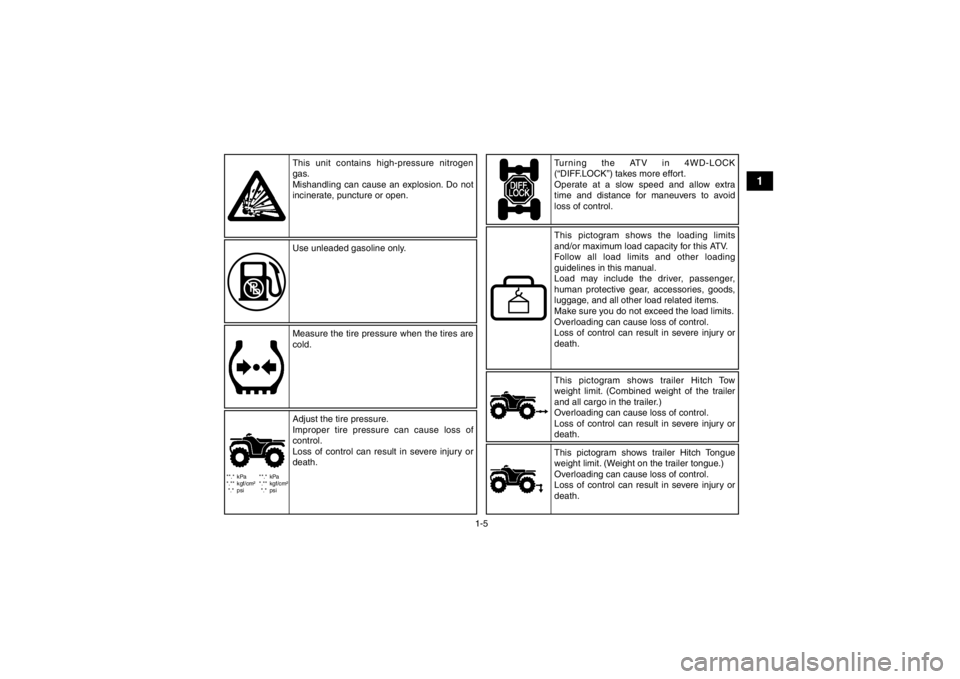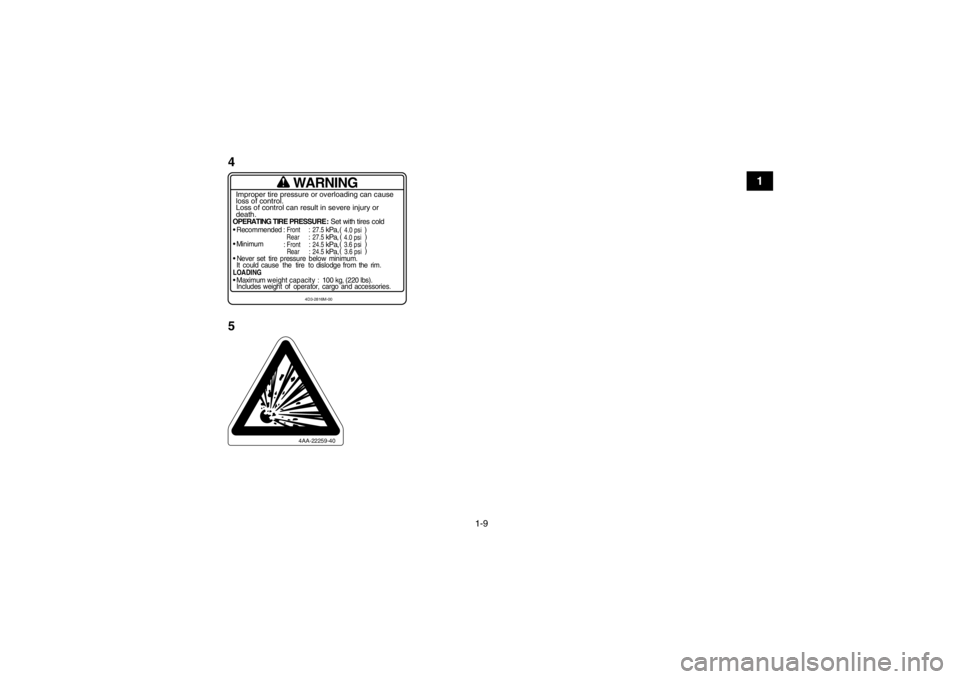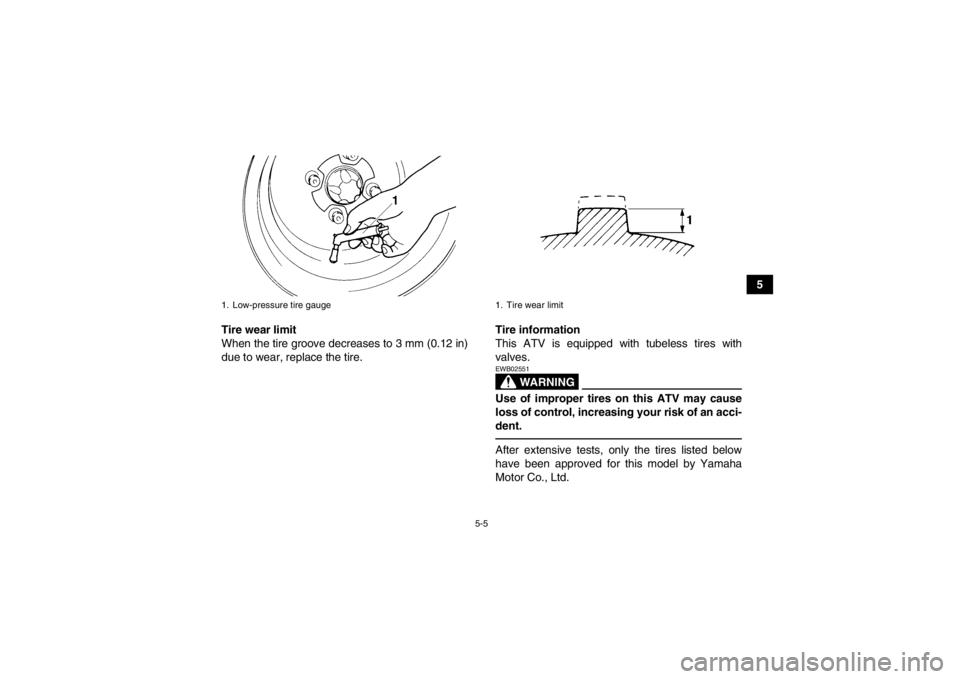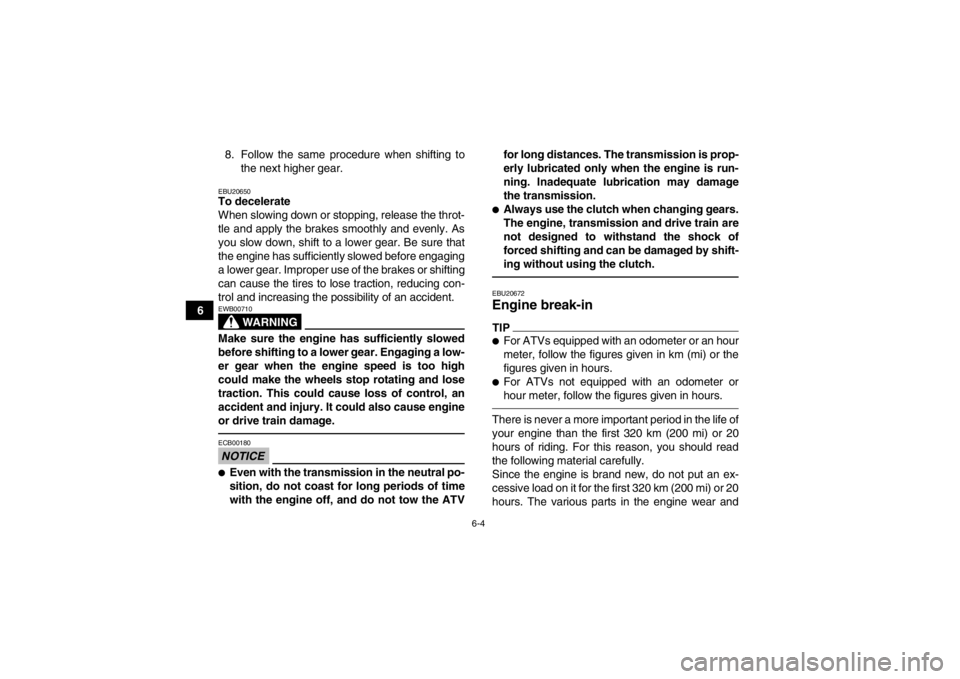tires YAMAHA YFM250R 2013 Owners Manual
[x] Cancel search | Manufacturer: YAMAHA, Model Year: 2013, Model line: YFM250R, Model: YAMAHA YFM250R 2013Pages: 136, PDF Size: 3.44 MB
Page 8 of 136

EBU17420
TABLE OF CONTENTS
LOCATION OF THE WARNING AND
SPECIFICATION LABELS ............................ 1-1
SAFETY INFORMATION .............................. 2-1
DESCRIPTION .............................................. 3-1Left view ...................................................... 3-1
Right view.................................................... 3-1
Controls and instruments ............................ 3-2
INSTRUMENT AND CONTROL
FUNCTIONS .................................................. 4-1 Main switch ................................................ 4-1
Indicator light .............................................. 4-2
Handlebar switches .................................... 4-2
Throttle lever .............................................. 4-3
Speed limiter .............................................. 4-4
Clutch lever ................................................ 4-4
Brake lever ................................................. 4-5
Brake pedal ................................................ 4-5
Parking brake lever .................................... 4-6
Shift pedal .................................................. 4-7
Fuel tank cap .............................................. 4-7
Fuel ............................................................ 4-8 Fuel cock ....................................................4-9
Starter (choke) ..........................................4-11
Seat ..........................................................4-11
Adjusting the front shock absorber
assemblies ..............................................4-12
Adjusting the rear shock absorber assembly .................................................4-13
PRE-OPERATION CHECKS ..........................5-1 Fuel .............................................................5-3
Engine oil ....................................................5-3
Front and rear brakes .................................5-3
Throttle lever ...............................................5-3
Drive chain ..................................................5-4
Tires ............................................................5-4
Chassis fasteners .......................................5-6
Instruments, lights and switches .................5-6
OPERATION...................................................6-1 Starting a cold engine .................................6-1
Starting a warm engine ...............................6-2
Shifting ........................................................6-3
Engine break-in ...........................................6-4
Parking ........................................................6-5U1BT63E0.book Page 1 Friday, March 9, 2012 11:22 AM
Page 15 of 136

1-5
1
**.* kPa
*.** kgf/cm²*.* psi **.* kPa
*.** kgf/cm²
*.* psi
This pictogram shows trailer Hitch Tow
weight limit. (Combined weight of the trailer
and all cargo in the trailer.)
Overloading can cause loss of control.
Loss of control can result in severe injury or
death.
This unit contains high-pressure nitrogen
gas.
Mishandling can cause an explosion. Do not
incinerate, puncture or open.
Use unleaded gasoline only.
Measure the tire pressure when the tires are
cold. Turning the ATV in 4WD-LOCK
(“DIFF.LOCK”) takes more effort.
Operate at a slow speed and allow extra
time and distance for maneuvers to avoid
loss of control.
Adjust the tire pressure.
Improper tire pressure can cause loss of
control.
Loss of control can result in severe injury or
death. This pictogram shows the loading limits
and/or maximum load capacity for this ATV.
Follow all load limits and other loading
guidelines in this manual.
Load may include the driver, passenger,
human protective gear, accessories, goods,
luggage, and all other load related items.
Make sure you do not exceed the load limits.
Overloading can cause loss of control.
Loss of control can result in severe injury or
death.
This pictogram shows trailer Hitch Tongue
weight limit. (Weight on the trailer tongue.)
Overloading can cause loss of control.
Loss of control can result in severe injury or
death.
U1BT63E0.book Page 5 Friday, March 9, 2012 11:22 AM
Page 19 of 136

1-9
1
WARNING
OPERATING TIRE PRESSURE : Set with tires cold
Recommended
: Front
: 27.5
kPa,
Rear
: 27.5
kPa,
Minimum
: Front
: 24.5
kPa,
Rear
: 24.5
kPa,
Never set tire pressure below minimum.
It could cause the tire to dislodge from the rim.LOADINGMaximum weight capacity :
100 kg, (220 lbs).
Includes weight of operator, cargo and accessories.Improper tire pressure or overloading can cause
loss of control.
Loss of control can result in severe injury or
death.
4.0 psi
4.0 psi 3.6 psi
3.6 psi(
( )
() () )
4D3-2816M-00 4AA-22259-40
4
5
U1BT63E0.book Page 9 Friday, March 9, 2012 11:22 AM
Page 22 of 136

2-3
2
●Always use proper procedures if you stall or roll
backwards when climbing a hill. To avoid stall-
ing, use the proper gear and maintain a steady
speed when climbing a hill. If you stall or roll
backwards, follow the special procedure for
braking described in this manual. Dismount on
the uphill side or to a side if pointed straight up-
hill. Turn the ATV around and remount, following
the procedure described in this manual.●Always check for obstacles before operating in a
new area.●Never attempt to operate over large obstacles,
such as large rocks or fallen trees. Always follow
proper procedures when operating over obsta-
cles as described in this manual.●Always be careful when skidding or sliding.
Learn to safely control skidding or sliding by
practicing at low speeds and on level, smooth
terrain. On extremely slippery surfaces, such as
ice, go slowly and be very cautious in order to re-
duce the chance of skidding or sliding out of con-
trol.●Never operate an ATV in fast flowing water or in
water deeper than that recommended in this
manual. Remember that wet brakes may havereduced stopping ability. Test your brakes after
leaving water. If necessary, apply them several
times to let friction dry out the linings.
●Always use the size and type of tires specified in
this manual.●Always maintain proper tire pressure as de-
scribed in this manual.●Never exceed the stated load capacity for an
ATV. Cargo should be properly distributed and
securely attached. Reduce speed and follow in-
structions in this manual for carrying cargo or
pulling a trailer. Allow greater distance for brak-
ing.●Do not operate your ATV during darkness un-
less it is equipped with a properly functioning
headlight. Off-road riding is inherently danger-
ous and additionally, off-road trails do not have
streetlights to guide you.●Never maintain an ATV without proper knowl-
edge. Contact an authorized ATV dealer to in-
form you on basic ATV maintenance. Certain
maintenance can only be carried out by certified
staff.
U1BT63E0.book Page 3 Friday, March 9, 2012 11:22 AM
Page 44 of 136

5-2
5
Rear brake Check operation. If soft or spongy, have Yamaha dealer bleed hy-
draulic system.
Check brake pads for wear , and replace if necessary.
Check brake fluid level in reservoir, and add specified brake fluid to specified level if necessary.
Check hydraulic system for leakage. Correct if necessary. 5-3, 8-22, 8-23, 8-25
Clutch Check operation, and correct if necessary.
Lubricate cable if necessary.
Check lever free play, and adjust if necessary. 8-28
Throttle lever Make sure that operation is smooth. Lubricate cable and lever hous-
ing if necessary.
Check lever free play, and adjust if necessary. 5-3, 8-21
Control cables Make sure that operation is smooth. Lubricate if necessary. 8-31
Drive chain Check chain slack, and adjust if necessary.
Check chain condition. Lubricate if necessary.
5-4, 8-29, 8-31
Wheels and tires Check wheel condition, and replace if damaged.
Check tire condition and tread depth. Replace if necessary.
Check air pressure. Correct if necessary. 5-4
Shift pedal Make sure that operation is smooth.
Correct if necessary. 8-33
Brake pedal Make sure that operation is smooth. Lubricate pedal pivoting point if
necessary. 8-33
Brake and clutch levers Make sure that operation is smooth. Lubricate lever pivoting points if
necessary. 8-32
Chassis fasteners Make sure that all nuts, bolts and screws are properly tightened. 5-6
Instruments, lights and
switches Check operation, and correct if necessary. 5-6
ITEM ROUTINE PAGEU1BT63E0.book Page 2 Friday, March 9, 2012 11:22 AM
Page 46 of 136

5-4
5
EBU19770Drive chain Check the condition of the drive chain and check
the drive chain slack. Lubricate and adjust the
drive chain as necessary. (See page 8-29.)EBU19794Tires Check tire pressure regularly to make sure it is at
the recommended specifications. Also check for
wear and damage.
Tire pressure
Use the low-pressure tire gauge to check and ad-
just tire pressures when the tires are cold. Tire
pressures must be equal on both sides.
WARNING! Operation of this vehicle with im- proper tire pressure may cause severe injury
or death from loss of control or rollover. Tire
pressure below the minimum specified could
also cause the tire to dislodge from the rim un-
der severe riding conditions.
[EWB02541]
Set tire
pressures to the following specifications: The low-pressure tire gauge is included as stan-
dard equipment. Make two measurements of the
tire pressure and use the second reading. Dust or
dirt in the gauge could cause the first reading to be
incorrect.Recommended tire pressure:
Fro nt27.5 kPa (0.275 kgf/cm², 4.0 psi)
Rear 27.5 kPa (0.275 kgf/cm², 4.0 psi)
Minimum tire pressure: Fro nt24.5 kPa (0.245 kgf/cm², 3.6 psi)
Rear 24.5 kPa (0.245 kgf/cm², 3.6 psi)
Maximum tire seating pressure: Fro nt250 kPa (2.5 kgf/cm², 36 psi)
Rear 250 kPa (2.5 kgf/cm², 36 psi)
U1BT63E0.book Page 4 Friday, March 9, 2012 11:22 AM
Page 47 of 136

5-5
5
Tire wear limit
When the tire groove decreases to 3 mm (0.12 in)
due to wear, replace the tire. Tire information
This ATV is equipped with tubeless tires with
valves.
WARNING
EWB02551Use of improper tires on this ATV may cause
loss of control, increasing your risk of an acci-
dent.After extensive tests, only the tires listed below
have been approved for this model by Yamaha
Motor Co., Ltd.
1. Low-pressure tire gauge
1. Tire wear limit
U1BT63E0.book Page 5 Friday, March 9, 2012 11:22 AM
Page 48 of 136

5-6
5Aftermarket tires and rims
The tires and rims that came with your ATV were
designed to match the performance capabilities
and to provide the best combination of handling,
braking, and comfort. Other tires, rims, sizes, and
combinations may not be appropriate.
EBU19840Chassis fasteners Make sure that all nuts, bolts and screws are prop-
erly tightened.
EBU19850Instruments, lights and switches Check that all instruments, lights and switches are
working properly. Correct if necessary.
Front:
Manufacturer/model:DURO/DI-K102
Size: AT20 x 7-10
Ty p e : Tu b e l e s s
Rear: Manufacturer/model:DURO/DI-K502A
Size: AT 1 9 x 1 0 - 9
Ty p e : Tu b e l e s s
U1BT63E0.book Page 6 Friday, March 9, 2012 11:22 AM
Page 52 of 136

6-4
68. Follow the same procedure when shifting to
the next higher gear.
EBU20650To decelerate
When slowing down or stopping, release the throt-
tle and apply the brakes smoothly and evenly. As
you slow down, shift to a lower gear. Be sure that
the engine has sufficiently slowed before engaging
a lower gear. Improper use of the brakes or shifting
can cause the tires to lose traction, reducing con-
trol and increasing the possibility of an accident.
WARNING
EWB00710Make sure the engine has sufficiently slowed
before shifting to a lower gear. Engaging a low-
er gear when the engine speed is too high
could make the wheels stop rotating and lose
traction. This could cause loss of control, an
accident and injury. It could also cause engine
or drive train damage.NOTICEECB00180●Even with the transmission in the neutral po-
sition, do not coast for long periods of time
with the engine off, and do not tow the ATV for long distances. The transmission is prop-
erly lubricated only when the engine is run-
ning. Inadequate lubrication may damage
the transmission.
●Always use the clutch when changing gears.
The engine, transmission and drive train are
not designed to withstand the shock of
forced shifting and can be damaged by shift-
ing without using the clutch.EBU20672Engine break-in TIP●For ATVs equipped with an odometer or an hour
meter, follow the figures given in km (mi) or the
figures given in hours.●For ATVs not equipped with an odometer or
hour meter, follow the figures given in hours.There is never a more important period in the life of
your engine than the first 320 km (200 mi) or 20
hours of riding. For this reason, you should read
the following material carefully.
Since the engine is brand new, do not put an ex-
cessive load on it for the first 320 km (200 mi) or 20
hours. The various parts in the engine wear and
U1BT63E0.book Page 4 Friday, March 9, 2012 11:22 AM
Page 68 of 136
![YAMAHA YFM250R 2013 Owners Manual 7-12
7trol.
[EWB02631]
NOTICE: Do not shift gears without
releasing the throttle. Damage to the engine or
drive train may occur.
[ECB01071]
Use this same procedure as you move into the
higher gea YAMAHA YFM250R 2013 Owners Manual 7-12
7trol.
[EWB02631]
NOTICE: Do not shift gears without
releasing the throttle. Damage to the engine or
drive train may occur.
[ECB01071]
Use this same procedure as you move into the
higher gea](/img/51/53676/w960_53676-67.png)
7-12
7trol.
[EWB02631]
NOTICE: Do not shift gears without
releasing the throttle. Damage to the engine or
drive train may occur.
[ECB01071]
Use this same procedure as you move into the
higher gears. Be sure to coordinate the use of the
throttle and shift pedal properly.
Avoid higher speeds until you are thoroughly famil-
iar with the operation of your ATV.
When slowing down or stopping, release the throt-
tle and apply the brakes smoothly and evenly. As
you slow down, shift to a lower gear. Be sure that
the engine has sufficiently slowed before engaging
a lower gear. Improper use of the brakes or shifting
can cause the tires to lose traction, reducing con-
trol and increasing the possibility of an accident.
TURNING YOUR ATV
WARNING
EWB01771Always follow proper procedures for turning
as described in this Owner’s Manual. Practice
turning at low speeds before attempting to turn
at faster speeds. Do not turn at speeds too fast
for your skills or the conditions. ATV could go
out of control, causing a collision or overturn.
To achieve maximum traction on unpaved surfac-
es, the two rear wheels turn together at the same
speed. Therefore, unless the wheel on the inside
of the turn is allowed to slip or lose some traction,
the ATV will resist turning. A special turning tech-
nique must be used to allow the ATV to make turns
quickly and easily. It is essential that this skill be
learned first at low speed.
As you approach a curve, slow down and begin to
turn the handlebars in the desired direction. As you
do so, put your weight on the footrest to the outside
of the turn (opposite your desired direction) and
lean your upper body into the turn. Use the throttle
to maintain an even speed through the turn. This
maneuver will let the wheel on the inside of the turn
slip slightly, allowing the ATV to make the turn
properly.
U1BT63E0.book Page 12 Friday, March 9, 2012 11:22 AM